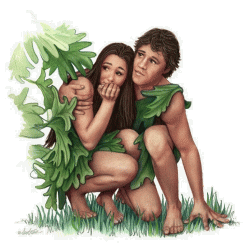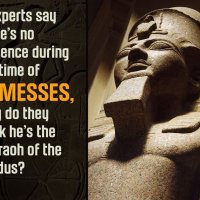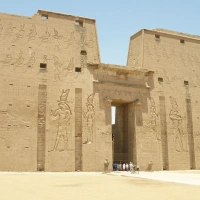Was the Garden of Eden where Adam and Eve began their lives a real place?
Did the Garden have real plants like flowers, vines, and trees? Did it have a real river with flowing water? Or was the Garden of Eden only an imaginative, mythical utopia?
Most scholars consider the Garden of Eden to be mythological. Even William F. Albright, the dean of Biblical Archaeology, believed Eden was a myth:
“Since the story of Eden is evidently a legend of composite character, perhaps folkloristic, but certainly embellished by the erudition of some scribe or school with somewhat hazy geographical conceptions, we must clearly follow the usual methods of comparative mythology and folklore.”
“Accordingly, we may feel assured that the story of Eden arose in Palestine under Mesopotamian influence and when embellished with geographical details was amalgamated with Egyptian conceptions, thus illustrating the interplay of Egyptian and Mesopotamian elements in Palestinian syncretism most beautifully.”
(W. F. Albright, The Location of the Garden of Eden, The American Journal of Semitic Languages and Literatures, University of Chicago Press, Vol. 39, No. 1 (Oct., 1922), pp. 17, 27.)
Does the Bible depict the Garden of Eden as a mythological location? What does the Bible teach about Eden? Does it present the Garden of Eden as historical and geographical fact or as a mythical fantasy, as so many scholars would have us believe?
The Garden of Eden — A Geographic Reality
Eden’s location may be an enigma to us today, but it was an actual place on earth. Eden was not a legend, symbol, or myth. The Garden of Eden was a historical and geographic reality.
Scripture’s geographical specifics for the location of the garden rule out Eden’s being fictional. In fact, the location information given in Genesis is much more detailed than that for most other Biblical sites.
The Lord God planted a garden toward the east, in Eden; and there He placed the man whom He had formed. Out of the ground the Lord God caused to grow every tree that is pleasing to the sight and good for food; the tree of life also in the midst of the garden, and the tree of the knowledge of good and evil.
Now a river flowed out of Eden to water the garden; and from there it divided and became four rivers. The name of the first is Pishon; it flows around the whole land of Havilah, where there is gold. The gold of that land is good; the bdellium and the onyx stone are there. The name of the second river is Gihon; it flows around the whole land of Cush. The name of the third river is Tigris; it flows east of Assyria. And the fourth river is the Euphrates.
Then the Lord God took the man and put him into the garden of Eden to cultivate it and keep it. The Lord God commanded the man, saying, “From any tree of the garden you may eat freely; but from the tree of the knowledge of good and evil you shall not eat, for in the day that you eat from it you will surely die.” (Genesis 2:8-17 NASB)
The straightforward details of this passage indicate a real Garden with a real river. The compass direction “east” is specified for Eden. What would a compass direction mean if Eden were mythical?
Landmark rivers flowing from Eden’s river are named. Physical lands where they flowed are named and described. Even today, man still uses rivers as boundaries and landmarks for real, physical locations.
Furthermore, Genesis explicitly reports that Yahweh Himself planted the Garden of Eden and placed Adam in it (Genesis 2:8,15). Trees grew there including the Tree of Life and the Tree of the Knowledge of Good and Evil. How could the real man Adam be placed in a mythical place?
Adam and Eve ate from the Tree of the Knowledge of Good and Evil in the middle of the Garden of Eden. Their disobedience brought sin and death and centuries of trouble into Yahweh’s perfect creation. Sin and death are obviously real consequences in real time affecting real lives of real people, including you and me. So Adam’s rebellion in eating the Forbidden Fruit must have been real. So the tree that produced the fruit must have been real. Therefore the Garden in which it grew must have been real.
Only tangible, physical fig leaves would provide the covering the guilty couple sought (Genesis 3:7). This requires a real fig tree in Eden from which they procured the real leaves. A real fig tree requires a real garden in which to grow.
Genesis also reports that Yahweh walked in the garden and that Adam and Eve hid in the garden after they sinned (Genesis 3:8). You can’t walk or hide in a mythical garden.
Later Yahweh drove Adam and Eve out from Eden, and He stationed guarding cherubim on the east side of Eden. So Eden had to be a real place. You can’t put a man in a mythical place and then kick him out of a mythical location. You don’t need to station guards to prevent entry to a mythical place.
Then the Lord God said, “Behold, the man has become like one of Us, knowing good and evil; and now, he might stretch out his hand, and take also from the tree of life, and eat, and live forever” —— therefore the Lord God sent him out from the garden of Eden, to cultivate the ground from which he was taken. So He drove the man out; and at the east of the garden of Eden He stationed the cherubim and the flaming sword which turned every direction to guard the way to the tree of life. (Genesis 3:22-24 NASB)
Cain’s exile was described relative to Eden: he settled in the land of Nod, east of Eden (Genesis 4:16). Since Nod must have been a real place to which Cain went, then specifying its location relative to Eden means Eden must have been a real place also.
The author of Genesis obviously intended the Garden of Eden to be understood as a real geographic place.
The prophets Isaiah (51:3), Ezekiel (28:13; 31:9; 31:18; 36:35), and Joel (2:3) all reference Eden as a real place.
The Garden of Eden is now undoubtedly covered by hundreds or even thousands of feet of sediment from Noah’s Flood; it is probably impossible to locate. Nevertheless, the Garden of Eden was certainly an actual geographical location somewhere on earth at the beginning of history around 6,000 years ago.
It is clear that the Bible teaches that the Garden of Eden was a historical and geographic reality. It was a real place on earth. Jesus believed what Moses wrote in Genesis, and He expected others to believe it also (John 5:46-47). Those who claim Jesus as Lord must accept His view as their own.
For more on the Garden of Eden click and read
Where Was Adam’s Garden of Eden?
Questions to Ponder
- Where on earth do you think the Garden of Eden was physically located?
- What are the logical and theological ramifications of a disbelief in the Garden of Eden?
Share your thoughts on these questions in the comments below. It could encourage or help another reader.
Soli Deo Gloria.
This is the 12th of a series of weekly blog articles on Adam.
Read the prequels:
1. Was Adam in the Garden of Eden?
2. Did Moses Believe in Adam?
3. Did Jesus Believe in Adam?
4. Did Paul Believe in Adam?
5. Does Belief in Adam Matter?
6. Adam and Puppies
7. Why Did Adam Sin?
8. What Should Adam Have Done?
9. What Did Adam Cause?
10. What Was Adam’s Forbidden Fruit?
11. How Long Was Adam in Eden?
Read the sequels:
13. Christmas & Adam (with videos)
14. Where Was Adam’s Garden of Eden?
15. Did Adam Wear Clothes in Eden?
16. Was Adam Backward or Brilliant? (with video)
17. Who Was Mrs. Adam?
18. Adam’s Dream Girl
19. Adam’s Prolific Princess
20. Adam’s Problematic Princess
21. How Many Children Did Adam Have?
22. Whom Did Adam’s Sons Marry?
23. Did Adam Ride a Unicorn?
24. How Long Did Adam Live?
25. Did Adam Swat Mosquitoes in Eden?
26. Did Adam’s Garden Have a Talking Snake?
27. Why Should Adam’s Sin Affect Me?
28. Did Roses Have Thorns in Adam’s Garden?
29. Adam the Image-Bearer & Harambe the Gorilla
30. Did Adam Ever Return to Eden?
31. What Was Adam’s Tree of Life?
32. Will Adam Be in Heaven?
33. Did Adam See the Big Dipper?
34. Did Adam Know Earth Is Round?
35. Did Jesus Say When Adam Was Created?
36. Did Adam See Dinosaurs?
37. Did Adam Like Steak?
38. Could Adam Read & Write?
39. Did God Use Evolution to Make Adam?
40. Adam & the Olympics
41. Adam and the Gospel
42. Adam and the Genesis Road
Subscribe – Don’t miss future blog posts!
Click the sidebar’s “SUBSCRIBE” button to follow the
Bible-Science Guy Blog. You’ll automatically receive
new posts free by email. Click SUBSCRIBE NOW!
©William T. Pelletier, Ph.D.
“contending earnestly for the faith”
“destroying speculations against the knowledge of God”
“for the defense of the gospel”
(Jude 1:3; 2 Cor 10:5; Phil 1:16)
Wednesday December 16, 2015 A.D.
The Lord God commanded the man, saying, “From any tree of the garden you may eat freely; but from the tree of the knowledge of good and evil you shall not eat, for in the day that you eat from it you will surely die.”
Now the serpent was more crafty than any beast of the field which the Lord God had made. And he said to the woman, “Indeed, has God said, ‘You shall not eat from any tree of the garden’?” The woman said to the serpent, “From the fruit of the trees of the garden we may eat; but from the fruit of the tree which is in the middle of the garden, God has said, ‘You shall not eat from it or touch it, or you will die.’” The serpent said to the woman, “You surely will not die! For God knows that in the day you eat from it your eyes will be opened, and you will be like God, knowing good and evil.” When the woman saw that the tree was good for food, and that it was a delight to the eyes, and that the tree was desirable to make one wise, she took from its fruit and ate; and she gave also to her husband with her, and he ate. (Genesis 2:16; 3:1-6)

































If the garden of eden is covered by hundreds or thousands of feet of sediment, how could the rivers mentioned in genesis still exist? At best, they are named after rivers that existed before the flood but that invalidates your original point that the garden must have existed because genesis mentions real rivers. You can’t have both the garden and the flood.
Even if we forget the above point for a second, just because a story includes real places, it doesn’t make the story true. Spiderman is set in New York but we should not assume Spiderman is real. The same applies to Adam. Plenty of origin myths include real places. According to the Maori, a demi-god Maui went out in his boat and pulled up a giant fish that became the North Island of NZ. His canoe is now the South Island. Should we believe that literally just because real places are mentioned?
LikeLike
By: FranktonJohnston on December 16, 2015
at 7:14 am
Genesis mentions 5 real rivers that whose locations were described geographically. The entire topography of the earth, including the Garden of Eden, was destroyed by Noah’s Flood. Some of the pre-Flood rivers may follow similar routes following the Flood; some rivers may no longer exist.
The mention of real places is only part of the argument that Eden was real. The details of the entire context of the early chapters of Genesis, as outlined in the above blog post, contribute to the conclusion that the Garden of Eden was a real place.
LikeLike
By: BibleScienceGuy on January 9, 2016
at 4:24 pm
Two of the four rivers named that branch off of the river out of Eden were the Tigris and the Euphrates, so it seems like Eden would have been north of Mesopotamia, given that the rivers were flowing out of Eden and the Tigris and Euphrates rivers flow south into the Gulf of Persia. As interesting as it is to wonder about where Eden is I think its important to not get wrapped up in such things. We can’t return to the Garden of Eden, but we can look forward to the City of God when Yahweh makes all things new.
LikeLike
By: agoraofideas on December 20, 2015
at 4:41 pm
Yes, you’re right; the City of God is a certainty to which we look forward with exhilaration. Thanks for reading and for your insightful comments.
LikeLike
By: BibleScienceGuy on December 20, 2015
at 9:21 pm
Is it really possible 🤔
Hope so
LikeLike
By: Brandy on November 1, 2022
at 1:07 am